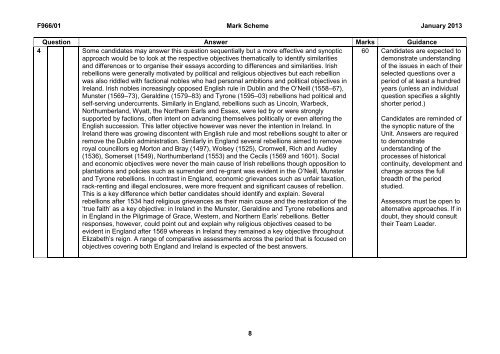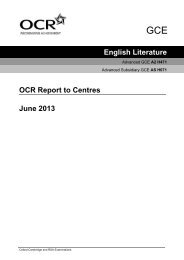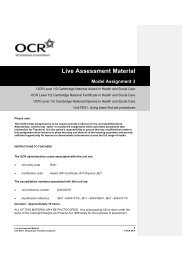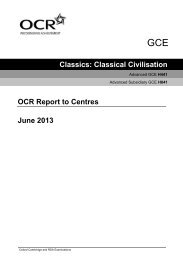Mark scheme - Unit F966/01 - Historical themes - Option A - OCR
Mark scheme - Unit F966/01 - Historical themes - Option A - OCR
Mark scheme - Unit F966/01 - Historical themes - Option A - OCR
You also want an ePaper? Increase the reach of your titles
YUMPU automatically turns print PDFs into web optimized ePapers that Google loves.
<strong>F966</strong>/<strong>01</strong> <strong>Mark</strong> Scheme January 2<strong>01</strong>3<br />
Question Answer <strong>Mark</strong>s Guidance<br />
4 Some candidates may answer this question sequentially but a more effective and synoptic<br />
approach would be to look at the respective objectives thematically to identify similarities<br />
and differences or to organise their essays according to differences and similarities. Irish<br />
rebellions were generally motivated by political and religious objectives but each rebellion<br />
was also riddled with factional nobles who had personal ambitions and political objectives in<br />
Ireland. Irish nobles increasingly opposed English rule in Dublin and the O’Neill (1558–67),<br />
Munster (1569–73), Geraldine (1579–83) and Tyrone (1595–03) rebellions had political and<br />
self-serving undercurrents. Similarly in England, rebellions such as Lincoln, Warbeck,<br />
Northumberland, Wyatt, the Northern Earls and Essex, were led by or were strongly<br />
supported by factions, often intent on advancing themselves politically or even altering the<br />
English succession. This latter objective however was never the intention in Ireland. In<br />
Ireland there was growing discontent with English rule and most rebellions sought to alter or<br />
remove the Dublin administration. Similarly in England several rebellions aimed to remove<br />
royal councillors eg Morton and Bray (1497), Wolsey (1525), Cromwell, Rich and Audley<br />
(1536), Somerset (1549), Northumberland (1553) and the Cecils (1569 and 16<strong>01</strong>). Social<br />
and economic objectives were never the main cause of Irish rebellions though opposition to<br />
plantations and policies such as surrender and re-grant was evident in the O’Neill, Munster<br />
and Tyrone rebellions. In contrast in England, economic grievances such as unfair taxation,<br />
rack-renting and illegal enclosures, were more frequent and significant causes of rebellion.<br />
This is a key difference which better candidates should identify and explain. Several<br />
rebellions after 1534 had religious grievances as their main cause and the restoration of the<br />
‘true faith’ as a key objective: in Ireland in the Munster, Geraldine and Tyrone rebellions and<br />
in England in the Pilgrimage of Grace, Western, and Northern Earls’ rebellions. Better<br />
responses, however, could point out and explain why religious objectives ceased to be<br />
evident in England after 1569 whereas in Ireland they remained a key objective throughout<br />
Elizabeth’s reign. A range of comparative assessments across the period that is focused on<br />
objectives covering both England and Ireland is expected of the best answers.<br />
60 Candidates are expected to<br />
demonstrate understanding<br />
of the issues in each of their<br />
selected questions over a<br />
period of at least a hundred<br />
years (unless an individual<br />
question specifies a slightly<br />
shorter period.)<br />
Candidates are reminded of<br />
the synoptic nature of the<br />
<strong>Unit</strong>. Answers are required<br />
to demonstrate<br />
understanding of the<br />
processes of historical<br />
continuity, development and<br />
change across the full<br />
breadth of the period<br />
studied.<br />
Assessors must be open to<br />
alternative approaches. If in<br />
doubt, they should consult<br />
their Team Leader.<br />
8
















